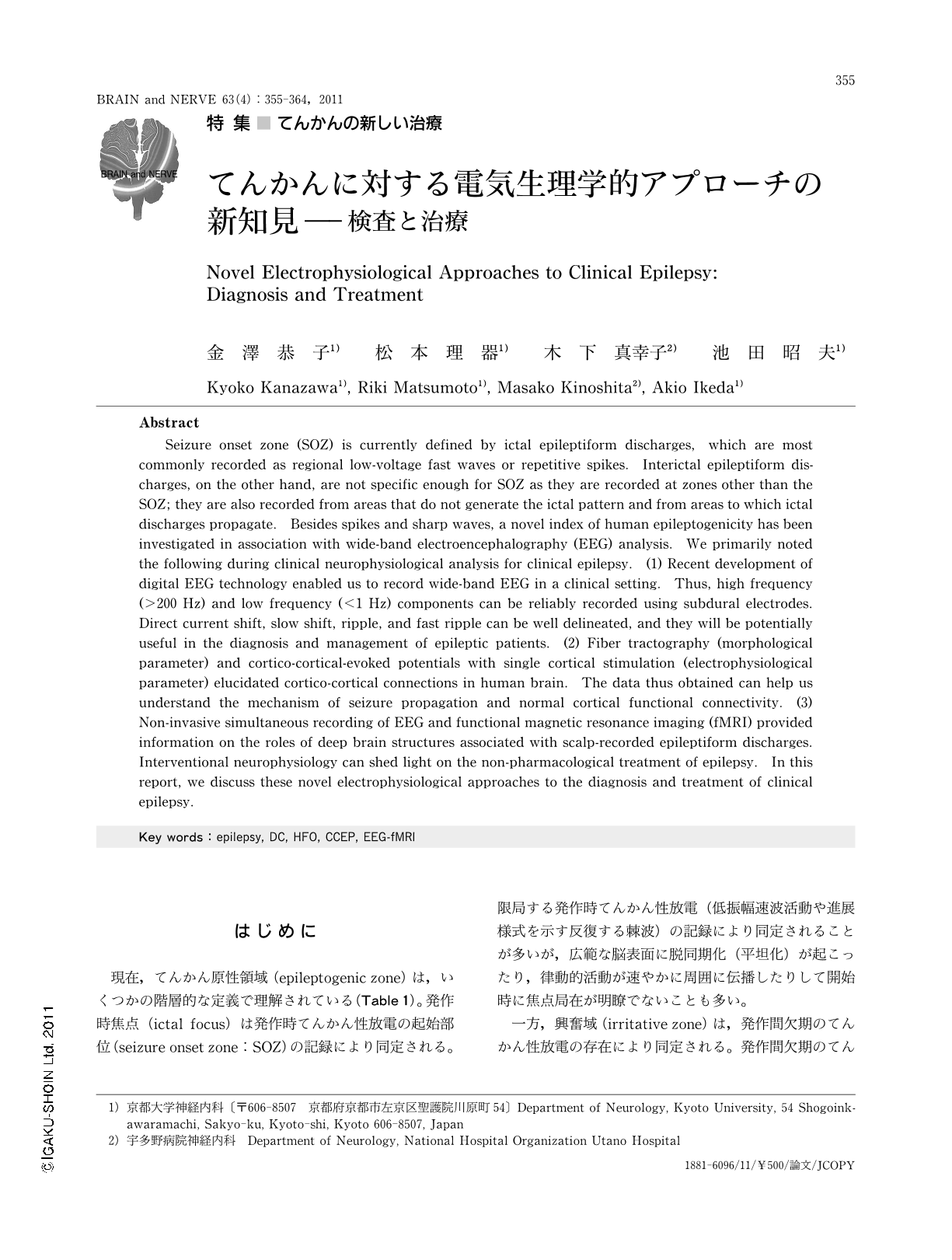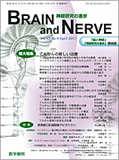Japanese
English
- 有料閲覧
- Abstract 文献概要
- 1ページ目 Look Inside
- 参考文献 Reference
はじめに
現在,てんかん原性領域(epileptogenic zone)は,いくつかの階層的な定義で理解されている(Table1)。発作時焦点(ictal focus)は発作時てんかん性放電の起始部位(seizure onset zone:SOZ)の記録により同定される。限局する発作時てんかん性放電(低振幅速波活動や進展様式を示す反復する棘波)の記録により同定されることが多いが,広範な脳表面に脱同期化(平坦化)が起こったり,律動的活動が速やかに周囲に伝播したりして開始時に焦点局在が明瞭でないことも多い。
一方,興奮域(irritative zone)は,発作間欠期のてんかん性放電の存在により同定される。発作間欠期のてんかん性放電は,てんかん焦点とその周囲以外に,焦点からてんかん性放電が伝播した領域にも出現することがある。例えば海馬硬化による内側側頭葉てんかんで,一側のみのてんかん原性焦点であっても,発作間欠期てんかん性放電は両側から記録されることは少なくない。このように,複数の領域に発作間欠期てんかん性放電が分布するときには必ずしも発作時焦点の同定に特異的な情報として役立つわけではない。発作間欠期てんかん性放電が必ずしもてんかん原性を示唆するとは限らないことから,red spike(てんかん原性が高く発作時焦点となる領域の発作間欠期てんかん性放電)をgreen spike(てんかん原性が低く発作時焦点にならない領域の発作間欠期てんかん性放電)の中からいかに峻別することができるかが,大きな命題であった1)。これには後述するように,最近発作間欠期てんかん性放電に伴うHFO(high frequency oscillation)の所見に期待が寄せられる。なお,現時点でred spikeと呼び得る所見は,cortical dysplasiaでのほぼ終始連続する1~2Hzのspikeのみであろう。
他方,ある連続した範囲の脳表面の領域がてんかん原性領域の場合,発作間欠期てんかん性放電の頻度分布がてんかん焦点の程度をある程度反映することは経験的によく知られ,その代表的な状態がcortical dysplasiaであろう。また,てんかん原性病変(epileptogenic lesion)とは,部分てんかんの原因と考えられる病理学的異常領域と定義される。
従来,大脳皮質の錐体細胞群の突発的過剰興奮を反映するspikes,sharp wavesは,脳波によるてんかん原性の定義に相当する所見としてとらえられてきた。後述するように,21世紀になり,広域帯域の脳波(wide-band electroencephalography:EEG)の記録が技術的に臨床の実用レベルで簡便に可能となった。錐体細胞群あるいはむしろグリア細胞の活動を反映する可能性が示唆される発作時直流電位(あるいは緩電位)や,介在ニューロンの活動を反映する可能性が示唆されるHFOと総称されるripple,fast rippleの記録が可能となり,その意義が現在検討されている(Table2)。
臨床てんかん学における脳波検査の意義は,大きく3点が挙げられる。まず1つはてんかん原性(epileptogenicity)という質的診断である。神経細胞が突発的に脱分極変位(paroxysmal depolarization shifts)2,3)を示すことがてんかん原性の定義であり,その本質はgiant EPSP(excitatory postsynaptic potential)と称されることもあるが3),これは脳波記録でしか診断できない。そのうち,外来脳波では発作間欠期てんかん性放電を記録することにより,irritabilityの評価が可能である。そのうえで長時間ビデオ脳波モニターにより発作時てんかん性放電を記録することにより,ictogenesisの評価が可能である4)。2つめの意義は,てんかん原性の局在(localization)の診断である。全般性てんかん性放電や局所性てんかん性放電の場合は頭皮上電極で,さらにてんかん手術においては脳内電極で評価を行う。3つめの意義は,徐波,すなわち非突発性異常により,機能低下の程度,分布を評価することである(Table3)。
本稿では,以上の臨床てんかん学における,既に確立された基本的な電気生理学的所見を踏まえ,21世紀になりにわかに注目されてきた,新しい電気生理学的知見に基づく診断と治療に関し概説する。具体的には,診断的アプローチとして,wide-band EEG,cortico-cortical evoked potentials(CCEP),脳波・機能的MRI(EEG-fMRI)の同時計測,さらに治療介入的神経生理学的手法を一部紹介する。なお,治療介入的神経生理学的手法の詳細は,本号の他稿を参照されたい。
Abstract
Seizure onset zone (SOZ) is currently defined by ictal epileptiform discharges, which are most commonly recorded as regional low-voltage fast waves or repetitive spikes. Interictal epileptiform discharges,on the other hand,are not specific enough for SOZ as they are recorded at zones other than the SOZ; they are also recorded from areas that do not generate the ictal pattern and from areas to which ictal discharges propagate. Besides spikes and sharp waves,a novel index of human epileptogenicity has been investigated in association with wide-band electroencephalography (EEG) analysis. We primarily noted the following during clinical neurophysiological analysis for clinical epilepsy. (1) Recent development of digital EEG technology enabled us to record wide-band EEG in a clinical setting. Thus,high frequency (>200 Hz) and low frequency (<1 Hz) components can be reliably recorded using subdural electrodes. Direct current shift,slow shift,ripple,and fast ripple can be well delineated,and they will be potentially useful in the diagnosis and management of epileptic patients. (2) Fiber tractography (morphological parameter) and cortico-cortical-evoked potentials with single cortical stimulation (electrophysiological parameter) elucidated cortico-cortical connections in human brain. The data thus obtained can help us understand the mechanism of seizure propagation and normal cortical functional connectivity. (3) Non-invasive simultaneous recording of EEG and functional magnetic resonance imaging (fMRI) provided information on the roles of deep brain structures associated with scalp-recorded epileptiform discharges. Interventional neurophysiology can shed light on the non-pharmacological treatment of epilepsy. In this report,we discuss these novel electrophysiological approaches to the diagnosis and treatment of clinical epilepsy.

Copyright © 2011, Igaku-Shoin Ltd. All rights reserved.


